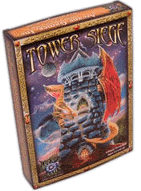
|
About OgreCave and its staff
|

|
by Craig Robertson
The basic concept of Tower Siege is remarkably simple: You are a wizard. Your sworn enemy is a wizard. Using your mystical and material resources, you summon arcane powers and craven minions to serve you in your efforts to destroy your opponent. A simple formula, but unfortunately, it's already been done. You see, the great-grandpappy of all CCGs, Magic: the Gathering, uses the exact same scenario. To be fair, most other CCGs also use the exact same scenario. Your opponent is a rival wizard (or warlord, emperor, rabid mutant dingo) whom you must destroy using your monsters (or troops, starships, rabid mutant dingoes) and mystic lore (or booby-traps, covert assets, rabid mutant dingo droppings). There is a good reason why WotC holds a valid patent on many aspects of CCG design. Therefore, the true question is this: does Tower Siege do a superior job of using that scenario to create an entertaining game? The game has a number of things going for it. The art by Colin McCulloch is colorful and attractive. The basic dice mechanic just happens to be my personal favorite: a simple percentile roll using two D10s. A success occurs when you roll under a card's skill level, as seen in Call of Cthulhu and almost anything by Palladium. The rest of combat is equally simple: the attacker rolls his attack skill, while the defender rolls hers. If they both succeed, there's no effect. If the attack succeeds and the defense fails, the defender takes one point of damage (fatal to most minions). If the defense succeeds against a failed attack roll, the defender may immediately make a counter-attack, or a riposte. There are also provisions for critical hits and fumbles, as well as saving throws provided by other game effects. The basic mechanics, therefore, are sound, and have the potential for supporting a great game. Unfortunately, the rest of the game does not live up to the mechanics. Tower Siege is marketed as a non-collectible, customizable card game. This pretty much means that what you see is what you get. And what you see is not a lot. After subtracting multiple resource cards (think basic lands), variant Mages, multiple Towers (identical except for card art), and reference cards, you are left with only 41 different minion, relic, item and scroll cards. This would not be so bad if the two decks offered in the basic set were not identical. Since you currently cannot count on more than 45 cards TOTAL in the new expansions, the game cannot possibly provide the infinite diversity in infinite combinations that even a minor CCG can. M:TG offered 290 different non-land cards in the Alpha set alone. Another staple of CCGs sadly lacking in Tower Siege is that of faction affiliations. You are given six different mages to choose from, but each one possesses the exact same starting spells and abilities. The only differences are in overall skill level and starting resources. The basic minions are all generic. There is absolutely nothing to distinguish one wizard from another. I am not a big fan of excessive background, but affiliations are a great way of adding depth to a game. By limiting certain abilities to specific factions, your opponent's style of play is reflected in his pre-game choices. For instance, the choice to build a Crab deck instead of a Crane deck in Legend of the Five Rings is more than a strategic option. It becomes an expression of the player's personality. While it is possible to create an enjoyable game using a limited number of cards, to do so requires an elegance throughout the entire design. Bruno Faidutti's Citadels has that elegance. Tower Siege does not. From the almost algebraic notation of minion special abilities to the dense and almost unreadable rules sheet, this game has too many difficulties standing in the way of too few rewards. Although the basic mechanics are workable, the lack of variety in the cards and the unnecessary similarities to M:TG make this game almost unpleasant to learn and play.
|
||
 Tower Siege
Tower Siege